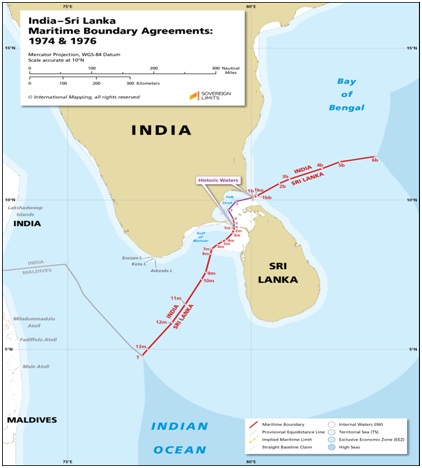Why Sri Lanka’s artificial reef plan for fish breeding is ‘toxic’ in India
- Posted By
10Pointer
- Categories
World Affairs
- Published
23rd Jun, 2021
-
-
Context
Sri Lanka’s recent initiative to create artificial reefs for breeding has riled Tamil Nadu fishers. The experts from India also called the move 'irresponsible'.
-
Background
- A recent Sri Lankan government initiative to dump discarded buses into chosen spots in the sea, to help create artificial reefs for fish breeding has come under criticism from across the Palk Strait.
- Fishers and experts in the south Indian state of Tamil Nadu have dubbed the initiative as ‘disastrous’, ‘unlawful’, and ‘irresponsible’.
- The low-intensity row began earlier this month, when the Sri Lankan government, with the help of its navy, dumped close to 20 discarded buses off the waters of the Deft Island, called Needuntheevu in Tamil, declaring that it would help fish breeding and restore the fast depleting marine life.
|
Deft island
- Locally known as Needuntheevu, Deft island is one of the closest points to India from northern Sri Lanka.
- Deft Island is at equal distance between Sri Lanka and India.
|
-
Analysis
What is an artificial reef?
- An artificial reef is a manmade structure that may mimic some of the characteristics of a natural reef.
- It is a human-made underwater structure that substitutes as a natural reef to form a habitat for marine life.
- Artificial reefs are placed in areas where there is little bottom topography or near coral reefs to attract marine populations.
- These structures are made from a variety of materials including shipwrecks, construction debris, oil rigs, concrete, and any other man-made objects.
|
Coral Reefs
- Coral reefs are large underwater structures composed of the skeletons of colonial marine invertebrates called coral.
- The three main types of coral reefs are fringing, barrier, and atoll.
- Fringing reef: Fringing reefs grow near the coastline around islands and continents. These types of reefs are the most common type.
- Barrier reef: These reef types border along coastlines with a very wide and deep lagoon separating the two structures.
- Atoll reef: An Atoll Reef is a ring-like shaped coral reef or small islands of reefs in a circle with a lagoon in the middle and are usually located in the middle of the sea.
|
-
What are India’s concerns?
- Negative impact on fishing industry: The buses would drift underwater into India’s territorial waters affecting fishing industry.
- The Tamil Nadu fishers say that their large and costly trawl nets could get caught in the dumped buses and get destroyed.
|
Trawling continues to the primary fishing practice for Tamil Nadu fishers, whereas it is banned in Sri Lanka. Tamil Nadu fishers trawl in Coramandel Waters, Palk Strait and Gulf of Mannar, which Sri Lanka also shares. The trawl nets can reach midwater and even the bottom of the sea.
|
- Affected trade: They further claimed that the practice would affect the trade and consumers alike in the coming months and years, thus, adding a new dimension to the intractable ‘fishers issue’ involving the two nations.
- Against the agreement: They also call the move against India–Sri Lanka maritime boundary agreements (1974 - 1976).
- Harmful to marine life: Debris of the kind could add toxicity to the marine life in the region.
-
Is drifting of underwater object possible?
- The drifting of unsupported objects under the water, due to ocean currents is a real phenomenon.
- For example: The drifting of debris of the aeroplane MH 370, which crashed in 2014, is an example of drifting induced by ocean currents. The debris drifted for hundreds of kilometres.
- Natural disasters like tsunamis and cyclones can drastically augment drifting.
-
How Sri Lanka reacted to India’s claims?
- The practice had helped breeding for deep sea fishing, which the nation’s southern Sinhala fishers have been very successful at.
- The country further claimed that the dumped vehicles would act as artificial reefs, and help the growth of slow-moving fish species and also provide them safety from faster varieties that otherwise fed on them.
- Artificial reef making has been in practice in the US since the 17th century and in Japan for over a century-and-half. According to the Minister, such practices had helped fish breeding and increase fish yields.
-
How maritime boundaries are agreed between India and Sri Lanka?
The maritime boundary agreements of 1974 and 1976—which delimited international boundaries in the Palk Bay and the Gulf of Mannar and Bay of Bengal, respectively.
- The maritime boundary between India and Sri Lanka was established though a pair of bilateral Agreements that were reached in 1974 and 1976 and spans some 288 km from the tripoint with the Maldives in the west to the 200 nautical mile limit of India and Sri Lanka in the east.
- Palk Strait (1974): The portion of the boundary that passes through the Palk Strait, which is defined as historic waters, was established based on the principle of modified equidistance in a 1974 Agreement.
- Gulf of Mannar (1976): The boundary in the Indian Ocean/Gulf of Mannar and in the Bay of Bengal was established in 1976 and follows a simplified equidistance line.

|
Palk Bay
- The Palk Bay is a narrow strip of water separating the state of Tamil Nadu in India from the Northern Province of Sri Lanka.
- The bay, which is 137 kilometers in length and varies from 64 to 137 kilometers (roughly 40 to 85 miles) in width, is divided by the International Maritime Boundary Line (IMBL).
- Bordering it are five Indian districts and three Sri Lankan districts.
|
-
Conclusion
Artificial reefs are beneficial because they can attract fish and other wildlife and as a result, tourism, recreational fishing and other commercial activities. However, such reefs are not perfect and suitable for all situations, as they can damage natural habitats.
